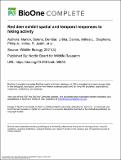Files in this item
Red deer exhibit spatial and temporal responses to hiking activity
Item metadata
| dc.contributor.author | Marion, Solène | |
| dc.contributor.author | Demsar, Urska | |
| dc.contributor.author | Davies, Althea | |
| dc.contributor.author | Stephens, Philip A. | |
| dc.contributor.author | Irvine, Justin | |
| dc.contributor.author | Long, Jed | |
| dc.date.accessioned | 2021-10-19T12:30:11Z | |
| dc.date.available | 2021-10-19T12:30:11Z | |
| dc.date.issued | 2021-10-08 | |
| dc.identifier | 275025001 | |
| dc.identifier | 745f5969-3c53-450b-90fc-2ec6a7c3df53 | |
| dc.identifier | 85120708088 | |
| dc.identifier | 000729376500010 | |
| dc.identifier.citation | Marion , S , Demsar , U , Davies , A , Stephens , P A , Irvine , J & Long , J 2021 , ' Red deer exhibit spatial and temporal responses to hiking activity ' , Wildlife Biology , vol. 2021 , no. 3 , wlb.00853 . https://doi.org/10.2981/wlb.00853 | en |
| dc.identifier.issn | 0909-6396 | |
| dc.identifier.other | ORCID: /0000-0001-7791-2807/work/101958876 | |
| dc.identifier.other | ORCID: /0000-0002-8982-7471/work/101958894 | |
| dc.identifier.other | ORCID: /0000-0001-9774-7386/work/101958970 | |
| dc.identifier.uri | https://hdl.handle.net/10023/24166 | |
| dc.description | Funding: This project is funded through a joint James Hutton Institute & University of St Andrews collaborative PhD Studentship, the Carnegie Trust and the British Deer Society. | en |
| dc.description.abstract | Outdoor recreation has the potential to impact the spatial and temporal distribution of animals. We explore interactions between red deer Cervus elaphus and hikers along a popular hiking path in the Scottish Highlands. We placed camera traps in transects at different distances (25, 75 and 150 m) from the path to study whether distance from hiker activity influences the number of deer detected. We compared this with the detection of red deer in an additional, spatially isolated area (one km away from any other transects and the hiking path). We collected count data on hikers at the start of the path and explored hourly (red deer detection during daytime), daily, diurnal (day versus night) and monthly spatial distributions of red deer. Using generalized linear mixed models with forward model selection, we found that the distribution of deer changed with the hiking activity. We found that fewer red deer were detected during busy hourly hiking periods. We found that during daytime, more red deer were detected at 150 m than at 25 m. Moreover, during the day, red deer were detected at a greater rate in the isolated area than around the transects close to the path and more likely to be found close to the path at night. This suggests that avoidance of hikers by red deer, in this study area, takes place over distances greater than 75 m and that red deer are displaced into less disturbed areas when the hiking path is busy. Our results suggest that the impact of hikers is short-term, as deer return to the disturbed areas during the night. | |
| dc.format.extent | 2241549 | |
| dc.language.iso | eng | |
| dc.relation.ispartof | Wildlife Biology | en |
| dc.subject | Camera traps | en |
| dc.subject | Outdoor activity | en |
| dc.subject | Recreation interaction | en |
| dc.subject | Spatio-temporal distribution | en |
| dc.subject | Ungulate | en |
| dc.subject | QH301 Biology | en |
| dc.subject | G Geography (General) | en |
| dc.subject | DAS | en |
| dc.subject.lcc | QH301 | en |
| dc.subject.lcc | G1 | en |
| dc.title | Red deer exhibit spatial and temporal responses to hiking activity | en |
| dc.type | Journal article | en |
| dc.contributor.sponsor | The British Deer Society | en |
| dc.contributor.sponsor | Carnegie Trust | en |
| dc.contributor.institution | University of St Andrews. Environmental Change Research Group | en |
| dc.contributor.institution | University of St Andrews. Bell-Edwards Geographic Data Institute | en |
| dc.contributor.institution | University of St Andrews. School of Geography & Sustainable Development | en |
| dc.contributor.institution | University of St Andrews. Centre for Energy Ethics | en |
| dc.contributor.institution | University of St Andrews. Geographies of Sustainability, Society, Inequalities and Possibilities | en |
| dc.identifier.doi | 10.2981/wlb.00853 | |
| dc.description.status | Peer reviewed | en |
| dc.identifier.grantnumber | RES2017 JI | en |
| dc.identifier.grantnumber | 70706 | en |
This item appears in the following Collection(s)
Items in the St Andrews Research Repository are protected by copyright, with all rights reserved, unless otherwise indicated.

